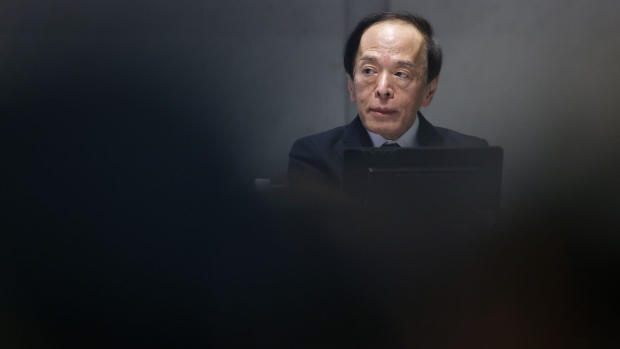Dec 26, 2023
BOJ Summary Suggests Ueda Can Wait for Wage Results Before Hike
, Bloomberg News

(Bloomberg) -- Bank of Japan board members discussed the potential timing of the nation’s first interest rate hike since 2007 during their meeting last week, with several members indicating they see no rush to make the move.
“It would not be too late even if the bank makes a decision after it sees developments in labor-management wage negotiations next spring,” one of nine board members said at the December 18-19 gathering. There is only a small risk of underlying inflation overshooting its 2% target by a significant degree, the same member said.
Another voiced the opinion that there is now “sufficient leeway” to determine whether a virtuous wage-inflation cycle has been achieved after the bank enhanced the flexibility of its yield curve control mechanism in October.
Those opinions may help cool market speculation as to whether policymakers will end the world’s last negative rate regime at their January meeting. Half of economists surveyed by Bloomberg earlier this month forecast the BOJ to pull the curtain down on the central banking world’s last negative policy rate with a hike in April, after the board assesses the first results of annual wage negotiations expected in March.
The yen weakened and yields fell after the release of the summary, an indication that investors’ initial impression was to nudge back their expectations of an imminent rate hike. Japan’s currency briefly weakened to 142.85 against the dollar while the yield on 10-year government debt fell 2 basis points to 0.610%. The yen subsequently clawed back most of the ground by lunchtime as investors digested the variety of views expressed in the summary.
Some opinions pointed to progress toward meeting the 2% target, and the risk that would arise if the bank had to tighten rapidly, so BOJ watchers will probably remain on watch for any potential surprises.
“While it is undesirable to make hasty decisions, it is ‘better to be rough and ready than slow and elaborate,’ as the saying goes,” one member noted in a comment that will help keep speculation of an early move next month smoldering.
Another pointed out that momentum in wage hikes “is stronger than last year,” in a sign of optimism over the prospects of achieving a virtuous wage-price cycle.
The variance in opinion itself may also explain why Ueda appeared in no hurry to make a move when he spoke after the December meeting, according to Mari Iwashita, chief market economist at Daiwa Securities.
Still, she noted that use of the words “exit” and “normalization” in the summary increased to five from three at the previous meeting in October, another indication that the BOJ is getting closer to paring back stimulus.
“It is important for the bank to continue to deepen discussions on issues such as the timing of the exit from the current monetary policy and the appropriate pace of raising policy interest rates,” one member said.
The BOJ holds its next policy meeting from Jan. 22-23. Some 15% of economists surveyed before the BOJ’s December meeting forecast the bank will scrap the negative rate in January.
--With assistance from Saburo Funabiki.
(Adds further market details and analyst comment)
©2023 Bloomberg L.P.






